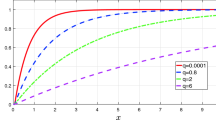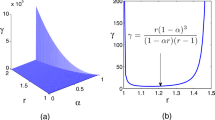Abstract
In this paper, we consider a reaction–diffusion mussel–algae model with state-dependent mussel mortality. This mortality involves a positive feedback term resulting from the reduction of dislodgment and predation and a negative feedback term resulting from the intraspecific competition for mussel. We first study the global stability of the nonnegative uniform steady states and then focus on the existence and nonexistence of nonconstant positive steady states. The global bifurcation of constant positive steady state is also considered. Our results suggest that the regular patterning in mussel beds may be caused by the high mobility of algae or the low diffusion of mussels.




Similar content being viewed by others
References
Ainseba BE, Bendahmane M, Noussair A (2008) A reaction–diffusion system modeling predator–prey with prey-taxis. Nonlinear Anal Real World Appl 9:2086–2105
Britton NF (1989) Aggregation and the competitive exclusion principle. J Theor Biol 136:57–66
Britton NF (1990) Spatial structures and periodic travelling waves in an integro-differential reaction-diffusion population model. SIAM J Appl Math 50:1663–1688
Callahan TK, Knobloch E (1999) Pattern formation in three-dimensional reaction-diffusion systems. Phys D 132:339–362
Cangelosi RA, Wollkind DJ, Kealy-Dichone BJ, Chaiya I (2015) Nonlinear stability analyses of Turing patterns for a mussel-algae model. J Math Biol 70:1249–1294
Chen S, Shi J, Wei J (2013) The effect of delay on a diffusive predator-prey system with Holling Type-II predator functional response. Comm Pure Appl Anal 12:481–501
Conway E, Hoff D, Smoller J (1978) Large time behavior of solutions of systems of nonlinear reaction-diffusion equations. SIAM J Appl Math 35:1–16
Henry D (1981) Geometric theory of semilinear parabolic equations. Lecture notes in mathematics, vol 840. Springer, Berlin
Hollis SL, Martin RH Jr, Pierre M (1987) Global existence and boundedness in reaction-diffusion systems. SIAM J Math Anal 18:744–761
Kareiva P, Odell G (1987) Swarms of predators exhibit “preytaxis” if individual predators use area-restricted search. Am Nat 130:233–270
Klausmeier CA (1999) Regular and irregular patterns in semiarid vegetation. Science 284:1826–1828
Lieberman GM (2005) Bounds for the steady-state Sel’kov model for arbitrary p in any number of dimensions. SIAM J Math Anal 36:1400–1406
Lin C, Ni W, Takagi I (1988) Large amplitude stationary solutions to a chemotaxis system. J Differ Equ 72:1–27
Liu Q, Weerman EJ, Herman PMJ, Han O, Johan VDK (2012) Alternative mechanisms alter the emergent properties of self-organization in mussel beds. Proc R Soc B 279:2744–2753
Liu Q, Doelman A, Rottschäfer V, Jager MD, Herman PMJ (2013) Phase separation explains a new class of self-organized spatial patterns in ecological systems. Proc Natl Acad Sci USA 110:11905–11910
Liu Q, Herman PMJ, Mooij WM, Huisman J, Scheffer M, Olff H, van de Koppel J (2014) Pattern formation at multiple spatial scales drives the resilience of mussel bed ecosystems. Nat Commun 5:5234
Lou Y, Ni W (1996) Diffusion, self-diffusion and cross-diffusion. J Differ Equ 131:79–131
Malchow H (1996) Nonlinear plankton dynamics and pattern formation in an ecohydrodynamic model system. J Mar Syst 7:193–202
Nirenberg L (1974) Topics in nonlinear functional analysis. American Mathematical Society, Providence
Pang PYH, Wang M (2003) Qualitative analysis of a ratio-dependent predator–prey system with diffusion. Proc R Soc Edinb Sect A 133:919–942
Pang PYH, Wang M (2004) Non-constant positive steady states of a predator–prey system with non-monotonic functional response and diffusion. Proc Lond Math Soc 88(3):135–157
Pao CV (1992) Nonlinear parabolic and elliptic equations. Plenum Press, New York
Peng R, Zhao X (2016) A nonlocal and periodic reaction-diffusion-advection model of a single phytoplankton species. J Math Biol 72:755–791
Peng R, Shi J, Wang M (2007) Stationary pattern of a ratio-dependent food chain model with diffusion. SIAM J Appl Math 76:1479–1503
Peng R, Shi J, Wang M (2008) On stationary patterns of a reaction-diffusion model with autocatalysis and saturation law. Nonlinearity 21:1471–1488
Rabinowitz PH (1979) Some global results for nonlinear eigenvalue problems. J Funct Anal 7:487–513
Rietkerk M, Boerlijst MC, van Langevelde F et al (2002) Self-organization of vegetation in arid ecosystems. Am Nat 160:524–530
Shen Z, Wei J (2019a) Bifurcation analysis in a diffusive mussel-algae model with delay. Int J Bifur Chaos Appl Sci Eng 29:1950144
Shen Z, Wei J (2019b) Spatiotemporal patterns in a delayed reaction-diffusion mussel-algae model. Int J Bifur Chaos Appl Sci Eng 29:1950164
Sherratt JA (2013) History-dependent patterns of whole ecosystems. Ecol Complex 14:8–20
Sherratt JA, Mackenzie JJ (2016) How does tidal flow affect pattern formation in mussel beds? J Theoret Biol 406:83–92
Shigesada N, Okubo A (1981) Analysis of the self-shading effect on algal vertical distribution in natural waters. J Math Biol 12:311–326
Song Y, Jiang H, Liu Q, Yuan Y (2017) Spatiotemporal dynamics of the diffusive mussel-algae model near Turing–Hopf bifurcation. SIAM J Appl Dyn Syst 16:2030–2062
Turing AM (1952) The chemical basis of morphogenesis. Philos Trans R Soc Lond Ser A 237:37–72
van de Koppel J, Rietkerk M, Dankers N, Herman PMJ (2005) Self-dependent feedback and regular spatial patterns in young mussel beds. Am Nat 165:E66–77
van de Koppel J, Gascoigne JC, Theraulaz G, Rietkerk M, Mooij WM, Herman PMJ (2008) Experimental evidence for spatial self-organization in mussel bed ecosystems. Science 322:739–742
Volterra V (1928) Sur la théorie mathématique des phénomènes héréditaires. J Math Pures Appl 7:249–298
von Hardenberg J, Meron E, Shachak M, Zarmi Y (2001) Diversity of vegetation patterns and desertification. Phys Rev Lett 87:198101
Wang R, Liu Q, Sun G, Jin Z, van de Koppel J (2008) Nonlinear dynamic and pattern bifurcations in a model for spatial patterns in young mussel beds. J R Soc Interface 6:705–718
Wang J, Wei J, Shi J (2016) Global bifurcation analysis and pattern formation in homogeneous diffusive predator–prey systems. J Differ Equ 260:3495–3523
Zhao J, Wei J (2015) Dynamics in a diffusive plankton system with delay and toxic substances effect. Nonlinear Anal Real World Appl 22:66–83
Acknowledgements
The authors are grateful to the anonymous referees for their helpful comments and valuable suggestions which have improved the presentation of the paper.
Author information
Authors and Affiliations
Corresponding author
Additional information
Publisher's Note
Springer Nature remains neutral with regard to jurisdictional claims in published maps and institutional affiliations.
This research is supported by National Natural Science Foundation of China (No. 11771109).
Rights and permissions
About this article
Cite this article
Shen, Z., Wei, J. Stationary Pattern of a Reaction–Diffusion Mussel–Algae Model. Bull Math Biol 82, 51 (2020). https://doi.org/10.1007/s11538-020-00727-w
Received:
Accepted:
Published:
DOI: https://doi.org/10.1007/s11538-020-00727-w




